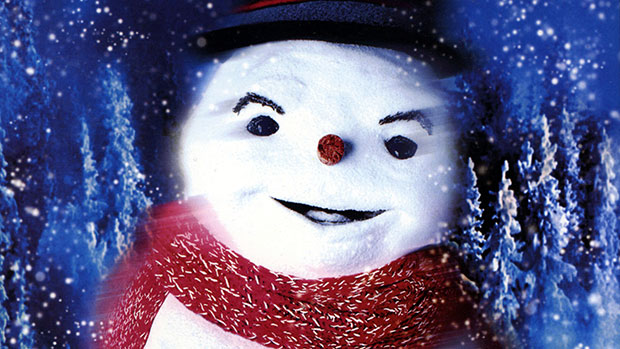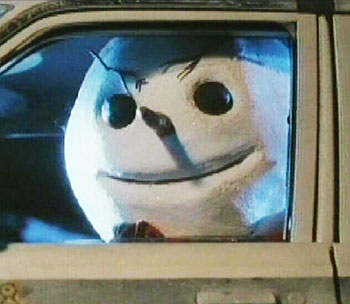
You’re probably going to die. That’s what the powers that be would have us believe, anyhow. And depending on the school of thought to which you subscribe, the form your hereafter will take can vary quite a bit: some will ascend to Heaven, some will approach Nirvana, some will crash land onto a polar bear-laden island until learning to appreciate the people around them. And some — a very select few, in fact — will turn into snowmen.
In the second half of a mystical, long-forgotten era known as the 1990s, the American Rockies were overtaken by a bizarrely specific phenomenon of human reincarnation. In 1997, just before Christmas, an apprehended serial killer was ostensibly killed when a collision of the police vehicle charged with delivering him to his imminent execution and a cargo truck filled with dangerous chemicals resulted in the dousing of the criminal with the gene-altering substances contained within the latter. Right around the same time, the snowy roads of Colorado took another victim: an aspiring musician and family man who was blinded by the inclement weather and driven to his presumed demise.
Both individuals were white American-born males nearing the age of 40, residents of the United States Mountain Region, and faced with a distinct character flaw that would fuel their eventual foray past the bounds of worldly mortality (one being too preoccupied with his blossoming music career to pay due attention to his young son; the other being a sociopathic murderer). And both men — these outliers in the grand constitution of science that facilitates our journeys through and limits within this unconscionable plight of being — were named Jack Frost.
Jack Frost vs. Jack Frost
You’ll probably remember the 1998 Warner Bros. feature Jack Frost, starring Michael Keaton as an absentee dad (the sort you’d find in just about every family movie in the ’90s, doesn’t it seem?) who dies, transforms into a snowman, and uses his new form to (ironically) warm the heart of his lonely son (Joseph Cross). You might not remember a similarly titled film released, in some capacity, a year earlier: Jack Frost, starring Scott MacDonald as a serial killer who dies, transforms into a snowman, and uses his new form to commit a string of murders in a nearby small town. So, is it name alone that these two films share? Let’s look at the similarities:
Title: Jack Frost, obviously
Hero’s name: Jack Frost — the absurdity of this is only referenced in the Keaton film.
Setting: Colorado (only explicitly stated in the Keaton film, although Denver is suggested to be nearby in the MacDonald picture).
Cause of death of hero: Vehicular accident (or, at least, something that happens immediately after a car accident).
Local annual winter festival: The significance is played up more greatly in the horror than in the family movie, but they both have one.
Precocious child who nobody else believes about the living snowman: They both have one.
Sledding bullies: Each has its own gaggle (the horror film’s get their comeuppance, the family film’s are shown to have inner good).
Prevalence of snow puns: Excessive throughout both movies, to the point where the vast majority of both Keaton’s and MacDonald’s dialogue can be followed by, “Get it? Because he’s a snowman!”
Inadequate law enforcement: Check and check.
Leaky kitchen pipes: Both have ’em.
And now, the differences:
 Directed by: Troy Miller (the family movie). Michael Cooney (the horror movie).
Directed by: Troy Miller (the family movie). Michael Cooney (the horror movie).
Rated: PG and R, respectively.
Hero’s plight: Keaton needs to redeem himself for being an inconsiderate father, and to bring his son to a point of emotional closure over his passing. MacDonald just wants to keep on killing, presumably until he does away with the man who caught him in the first place, Sheriff Tiler (Christopher Allport).
How he’s revived: Magic: Keaton is brought back thanks to a wish bequeathed upon him by son Charlie while playing the harmonica his dad gave him right before he died. Science: MacDonald’s genes are mutated and conjoined with the atomic makeup of the snow beneath him when he is doused with a Secret World of Alex Mack-esque chemical on the side of the highway.
Hero’s arms: Keaton has sticks, MacDonald has mitten-like snow arms.
Hero’s nose: Keaton has a button nose, a la Frosty, while MacDonald opts for the traditional carrot.
Hero’s weaknesses: Heat of any kind will melt, and do away with, Keaton. MacDonald can only be undone (and even then, for how long?!) by antifreeze.
Fate of the hero: Keaton dies, promising his son that he will always live on in his heart. MacDonald, supposedly, never dies, as we see his melted form bubbling hostilely beneath the Earth’s surface in a container of antifreeze in the last shot of the movie.
Lessons learned: Keaton’s: Family is more important than anything; never give up; death is a part of life; part of growing up means moving on. MacDonald’s: well, there’s this weird tangent about the human soul actually being a chemical bond, but it’s largely overlooked.
Zappas: Keaton’s has three (Dweezil, Ahmet, and Moon Unit), MacDonald’s has none.
So what are we to conclude about these stories? Wholly different in some ways, starkly similar in others, and remarkably close in their timing of release? Well, there’s really only one logical conclusion: they’re the same story, told from two very different perspectives.
Covered up by totalitarian Colorado news circuit was the story of a middle-aged everyman Jack Frost who was killed on the side of the road and then transformed, either right away or one year later, into a snowman. In an effort to learn more about the fantastic account, reporters hit his small mountain town, seeking out anyone who might be able to shed a light on the deceased. Eventually, they came upon someone wronged by the late Jack Frost: perhaps (as seen in the Keaton picture) an angry neighborhood hockey coach (Henry Rollins), one of the fellow’s shirked band members, or even young Charlie Frost, Jack’s neglected son. Any one of these figures might hold a grudge against the departed, painting him as such as a monstrous killer in an act of misguided vengeance.
But of course, diligent journalism would lead the investigators of this tale to friends of Jack: perhaps his best pal Mark Addy, one of the aforesaid Zappas, or his widow, Gabby (Kelly Preston). Any one of these individuals would surely describe Jack with elegiac holiness, making him out to be a saint beyond all others. Their grief would drive them to an idealization of a man prone to selfish acts, such as missing out on his son’s hockey game, or bombarding a bunch of helpless kids with a cavalcade of icy snowballs (that happens in the non horror movie).
Somewhere between these accounts rests the real story: the true account of an average jackass — not a horrible guy, but not a great one either — who lived a humdrum life before returning in snowman form to neither kill innocents nor guide his son to enlightenment. He probably just wandered around, confused and horrified, about the form he had taken, until his ultimate resting form as a solemn puddle on the side of a Rocky Mountain road. But Hollywood isn’t interested in middle grounds. They want extremes! Horror, blood, and gore! Or charm, laughs, and lessons! And so, the legend of Jack Frost was twisted, contorted, and itself transformed into something wholly… nonhuman: Jack Frost and Jack Frost. Two very different, highly fantastical movies about one regular guy who just happened to turn into a snowman one day.
[Photo Credit: Warner Bros, A-Pix Entertainment]
More:
What Your Favorite Christmas Movie Says About You
The Bright Lights of Hanukkah: The ‘Rugrats’ Special
‘The Hobbit’: What the Heck is a ‘Warg?’ Middle Earth Vocabulary For Non-Nerds





 50 Best Movies of 2012 — With Some Surprises! (Moviefone)
50 Best Movies of 2012 — With Some Surprises! (Moviefone)